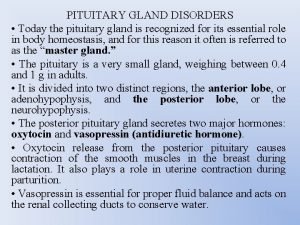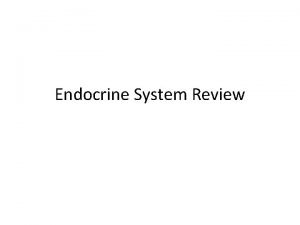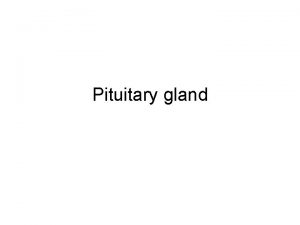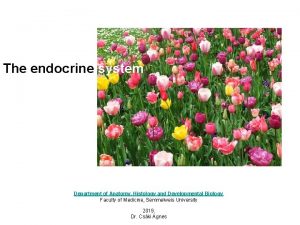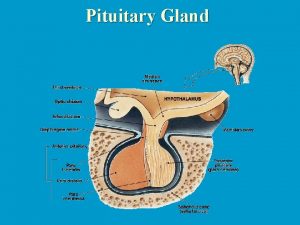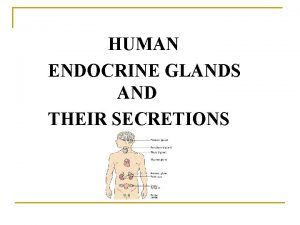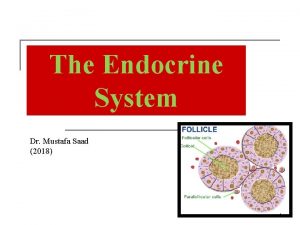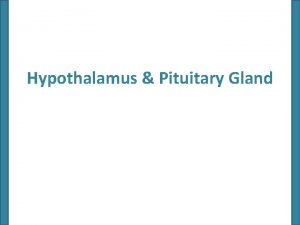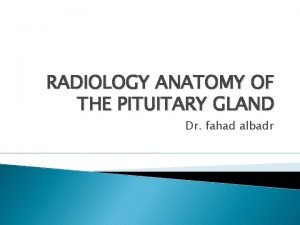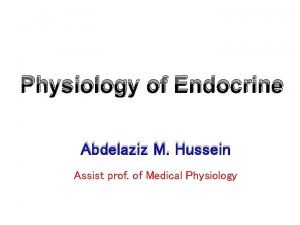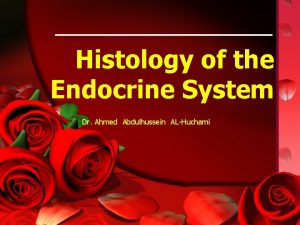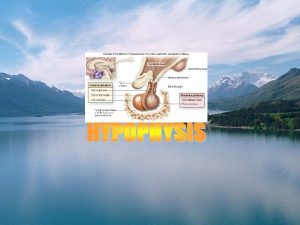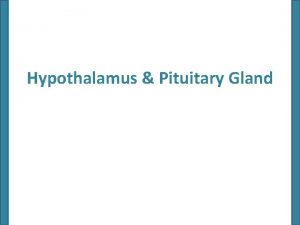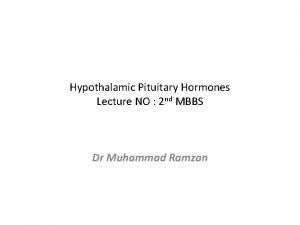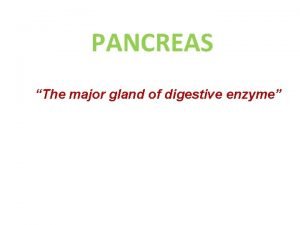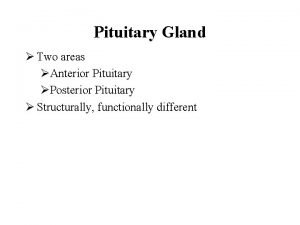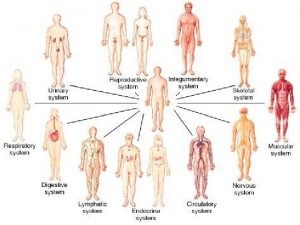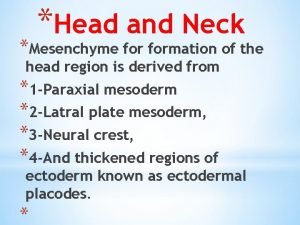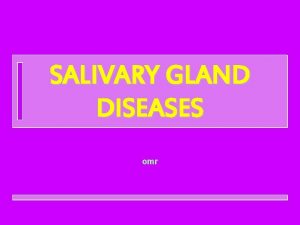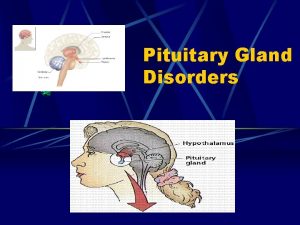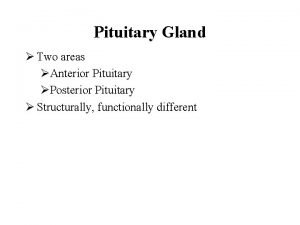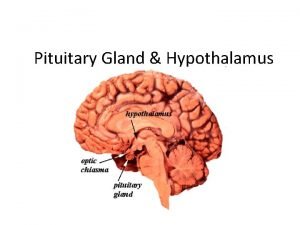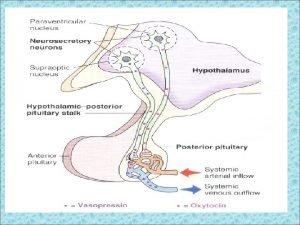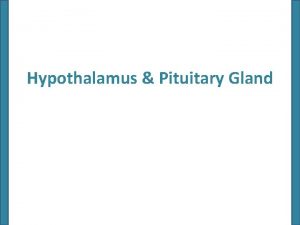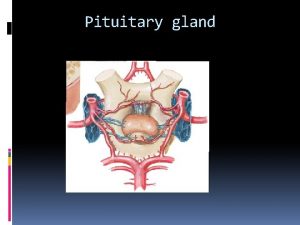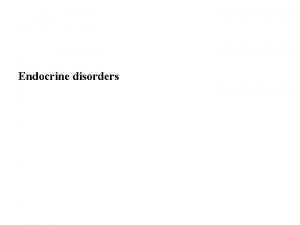PITUITARY GLAND DISORDERS Today the pituitary gland is
































- Slides: 32

PITUITARY GLAND DISORDERS • Today the pituitary gland is recognized for its essential role in body homeostasis, and for this reason it often is referred to as the “master gland. ” • The pituitary is a very small gland, weighing between 0. 4 and 1 g in adults. • It is divided into two distinct regions, the anterior lobe, or adenohypophysis, and the posterior lobe, or the neurohypophysis. • The posterior pituitary gland secretes two major hormones: oxytocin and vasopressin (antidiuretic hormone). • Oxytocin release from the posterior pituitary causes contraction of the smooth muscles in the breast during lactation. It also plays a role in uterine contraction during parturition. • Vasopressin is essential for proper fluid balance and acts on the renal collecting ducts to conserve water.

• The specialized secretory cells of the anterior pituitary lobe secrete six major polypeptide hormones. • These include: -growth hormone (GH) or somatotropin, -adrenocorticotropic hormone (ACTH) or corticotropin, -thyroid-stimulating hormone (TSH) or thyrotropin, -prolactin, -follicle-stimulating hormone (FSH), and -luteinizing hormone (LH).



GROWTH HORMONE EXCESS • Acromegaly is a pathologic condition characterized by excessive production of GH. • Gigantism, which is even more rare than acromegaly, is the excess secretion of GH prior to epiphyseal closure in children. • Patients diagnosed with acromegaly are reported to have a twofold to threefold increase in mortality, usually related to cardiovascular, respiratory, or neoplastic disease.

• The most common cause of excess GH secretion in acromegaly is a GH-secreting pituitary adenoma, accounting for approximately 98% of all cases. • Rarely, acromegaly is caused by ectopic GHsecreting adenomas, GH cell hyperplasia, or excess GHRH secretion, or is one of the manifestations of multiple endocrine neoplasia syndrome type 1, Mc. Cune-Albright’s syndrome, or the Carney complex, all very rare hypersecretory endocrinopathies.

Clinical Presentation of Acromegaly • General The patient will experience slow development of soft-tissue overgrowth affecting many body systems. Signs and symptoms may gradually progress over 7 to 10 years. • Symptoms The patient may complain of symptoms related to local effects of the growth hormone (GH)-secreting tumor, such as headache and visual disturbances. Other symptoms related to elevated GH and insulin-like growth factor-1 (IGF-1) concentrations include excessive sweating, neuropathies, joint pain, and paresthesias. • Signs The patient may exhibit coarsening of facial features, increased hand volume, increased ring size, increased shoe size, an enlarged tongue, and various dermatologic conditions.

Laboratory tests The patient’s GH concentration will be >1 mcg/L following an oral glucose tolerance test (OGTT) and IGF-1 serum concentrations will be elevated. Glucose intolerance may be present in up to 50% of patients. Additional clinical sequelae • Cardiovascular diseases such as hypertension, coronary heart disease, cardiomyopathy, and left ventricular hypertrophy are common in patients with acromegaly. • Osteoarthritis and joint damage develops in up to 90% of acromegalic patients. • Respiratory disorders and sleep apnea occur in up to 60% of acromegalic patients. • Type 2 diabetes develops in approximately 25% of acromegalic patients. • Patients with acromegaly may have an increased risk for development of esophageal, colon, and stomach cancer.

ACROMEGALY • The primary treatment goals for patients diagnosed with acromegaly are to reduce GH and IGF-1 concentrations, improve the clinical signs and symptoms of the disease, and decrease mortality. • The treatment of choice for most patients with acromegaly is transsphenoidal surgical resection of the GH-secreting adenoma.

• For patients who are poor surgical candidates, those who have not responded to surgical interventions, or others who refuse surgical treatment, radiation therapy may be considered. Radiation, however, may take several years to relieve the symptoms of acromegaly. • Because neither radiation therapy nor surgery will cure all patients with acromegaly, adjuvant drug therapy is often needed to control symptoms. • Drug therapy should be considered for acromegalic patients in whom surgery and irradiation are contraindicated, when rapid control of symptoms is indicated, or when other treatments have failed to normalize GH and IGF-1 concentrations.

DOPAMINE AGONISTS • In normal healthy adults, dopamine agonists cause an increase in GH production. However, when these agents are given to patients with acromegaly, there is a paradoxical decrease in GH production. • Most clinical experience with the use of dopamine agonists in acromegaly is with bromocriptine.

• For treatment of acromegaly, bromocriptine is initiated at a dose of 1. 25 mg at bedtime and is increased by 1. 25 -mg increments every 3 to 4 days as needed. • Doses as high as 80 mg/day have been used for treatment of acromegaly, but clinical studies have shown that dosages >20 or 30 mg daily do not offer additional benefits in the suppression of GH. • When used for treatment of acromegaly, the duration of action of bromocriptine is shorter than that for treatment of hyperprolactinemia. Therefore, the total daily dose of bromocriptine should be divided into three or four doses.

SOMATOSTATIN ANALOGS • Octreotide is a long-acting somatostatin analog that is approximately 40 times more potent in inhibiting GH secretion than is endogenous somatostatin. • The initial dose of octreotide for treatment of acromegaly is 100 mcg administered every 8 hours. • Some clinicians recommend a starting dose of 50 mcg every 8 hours, then increasing the dose to 100 mcg every 8 hours after 1 week, to improve the patient’s tolerance of adverse gastrointestinal effects. • The dose can be increased by increments of 50 mcg every 1 to 2 weeks based on mean serum GH and IGF 1 concentrations.

GROWTH HORMONE RECEPTOR ANTAGONIST • Pegvisomant is a genetically engineered GH derivative that binds to GH receptors in the liver and inhibits IGF-1. • This agent is different from other medications used in the management of acromegaly because it does not inhibit GH production; rather, it blocks the physiologic effects of GH on target tissues. • Therefore, GH concentrations remain elevated during therapy, and response to treatment is evidenced by a reduction in IGF-1 concentrations.


GROWTH HORMONE DEFICIENCY • Short stature is a condition that is commonly defined by a physical height that is more than two standard deviations below the population mean and lower than the third percentile for height in a specific age group. • A true lack of GH is among the least common causes and is known as growth hormone deficient (GHD) short stature. • Absolute GH deficiency is a congenital disorder that can result from various genetic abnormalities, such as GHRH deficiency, GH gene deletion, and developmental disorders including pituitary aplasia or hypoplasia.

Clinical Presentation of Short Stature General • The patient will have a physical height that is greater than two standard deviations below the population mean for a given age and gender. Signs • The patient will present with reduced growth velocity and delayed skeletal maturation. • Children with growth hormone (GH)-deficient or GH-insufficient short stature may also present with central obesity, prominence of the forehead, and immaturity of the face. Laboratory tests • The patient will exhibit a peak GH concentration <10 mcg/L following a GH provocation test. Reduced insulin-like growth factor-1 and insulin-like growth factor-1 binding protein-3 concentrations may be present. • Because GH deficiency may be accompanied by loss of other pituitary hormones, hypoglycemia and hypothyroidism may be noted.

TREATMENT • Recombinant GH is currently considered the mainstay of therapy for treatment of GHD short stature. • Somatropin is composed of the same amino acid sequence as human pituitary GH. • Recombinant GH formulations must be administered by intramuscular or subcutaneous injection. • The recommended dose for treatment of GHD short stature in children is 0. 3 mg/kg/wk. • Recombinant GH can be administered daily or in equal doses six times per week, depending on the specific GH product used.

• GH replacement therapy should be initiated as early as possible after diagnosis of GH insufficiency and continued until a desirable height is reached or growth velocity has decreased to <2. 5 cm per year after the pubertal growth spurt. • However, the suitable time point for discontinuation of therapy with growth-promoting doses remains controversial.

RECOMBINANT INSULIN-LIKE GROWTH FACTOR-1 • Recombinant IGF-1 products, consisting of either IGF-1 alone (mecasermin [Increlex]) or IGF-1 in combination with IGFBP-3 (mecasermin rinfabate [Iplex]), have been recently approved by the FDA for the treatment of children with short stature due to severe primary IGF-1 deficiency or GH gene deletion with neutralizing antibodies to GH. • The recommended dose of mecasermin is 0. 04 to 0. 12 mg/kg administered by subcutaneous injection twice daily.

GROWTH HORMONE-RELEASING HORMONE • A synthetic GHRH product known as sermorelin (Geref) currently is FDA approved for the treatment of idiopathic GH deficiency in children. • Sermorelin [GH-RH(1– 29)-NH 2] is composed of 29 amino acid residues that are identical to the amino-terminal segment of human GHRH. • The recommended dose of sermorelin is 0. 03 mg/kg administered daily by subcutaneous injection. • No serious adverse events have been identified.

HYPERPROLACTINEMIA • Hyperprolactinemia is a state of persistent serum prolactin elevation. • Prolactin concentrations >20 mcg/L observed on multiple occasions are generally considered indicative of hyperprolactinemia. • Hyperprolactinemia usually affects women of reproductive age. • The incidence of hyperprolactinemia in the general population is reported to be <1%.

Clinical Presentation of Hyperprolactinemia General Hyperprolactinemia most commonly affects women and is very rare in men. Signs and symptoms • The patient may complain of symptoms related to local effects of the prolactin secreting tumor, such as headache and visual disturbances, that result from tumor compression of the optic chiasm. • Female patients experience oligomenorrhea, amenorrhea, galactorrhea, infertility, decreased libido, hirsutism, and acne. • Male patients experience decreased libido, erectile dysfunction, infertility, reduced muscle mass, galactorrhea, and gynecomastia. Laboratory tests Prolactin serum concentrations at rest will be >20 mcg/L on multiple occasions. Additional clinical sequelae • Prolonged suppression of estrogen in premenopausal women with hyperprolactinemia leads to decreases in bone mineral density and significant risk for development of osteoporosis. • Risk for ischemic heart disease may be increased with untreated hyperprolactinemia.

• The treatment of hyperprolactinemia depends on the underlying cause of the abnormality. • In cases of drug-induced hyperprolactinemia, discontinuation of the offending medication and initiation of an appropriate therapeutic alternative usually normalizes serum prolactin concentrations. • In cases for which an appropriate therapeutic alternative does not exist, medical therapy with dopamine agonists is warranted. • Sex-steroid replacement also should be considered.

• Treatment options for the management of prolactinomas include: -clinical observation, -medical therapy with dopamine agonists, -radiation therapy, and -transsphenoidal surgical removal of the tumor. • The goal of therapy is to normalize prolactin serum concentrations and reestablish gonadotropin secretion to restore fertility and reduce the risk of osteoporosis. • Transsphenoidal surgery for removal of prolactinomas usually is reserved for patients who are refractory to or cannot tolerate therapy with dopamine agonists and for patients with very large tumors that cause severe compression of adjacent tissues. • Radiation therapy may require several years for effective tumor shrinkage and reduction in serum prolactin concentrations and usually is used only in conjunction with surgery.

PHARMACOLOGIC THERAPY • Medical therapy with dopamine agonists has proven to be very effective in normalizing prolactin serum concentrations, restoring menstruation, and reducing tumor size in approximately 80% to 90% of patients within 3 to 6 months of therapy. • Bromocriptine has been the mainstay of therapy since the 1970 s. • Cabergoline is a long-acting dopamine agonist that offers the advantage of less frequent dosing. • In recent years cabergoline has replaced bromocriptine as the agent of choice for the medical management of prolactinomas.

• Bromocriptine was the first D 2 -receptor agonist to be used in the treatment of hyperprolactinemia and has been the mainstay of therapy for over 20 years. It inhibits the release of prolactin by directly stimulating postsynaptic dopamine receptors in the hypothalamus. • Cabergoline is a long-acting dopamine agonist with high selectivity and affinity for dopamine D 2 receptors.

• Medical therapy with bromocriptine normalizes prolactin serum concentrations, restores gonadotropin production, and shrinks tumor size in approximately 90% of patients with microprolactinomas and 70% of patients with macroprolactinomas. • Cabergoline also effectively reduces tumor size in patients with both microprolactinomas and macroprolactinomas. Cabergoline also has proved effective in patients who are intolerant of or resistant to bromocriptine, and recent data suggest that cabergoline is as effective in men as in women with microprolactinomas and macroprolactinomas.

• For the management of hyperprolactinemia, bromocriptine therapy typically is initiated at a dose of 1. 25 to 2. 5 mg once daily at bedtime to minimize adverse effects. The dose can be gradually increased by 1. 25 -mg increments every week to obtain desirable serum prolactin concentrations. Usual therapeutic doses of bromocriptine range from 2. 5 to 15 mg/day, although some patients may require doses as high as 40 mg/day. • The initial dose of cabergoline for treatment of hyperprolactinemia is 0. 5 mg once weekly or in divided doses twice weekly. This dose may be increased by 0. 5 -mg increments at 4 -week intervals based on serum prolactin concentrations. The usual dose is 1 to 2 mg weekly; however, doses as high as 4. 5 mg weekly have been used.

• The most common adverse effects associated with bromocriptine therapy include CNS symptoms such as headache, lightheadedness, dizziness, nervousness, and fatigue. Gastrointestinal effects such as nausea, abdominal pain, and diarrhea also are common. • The most common adverse effects reported with use of cabergoline are nausea, vomiting, headache, and dizziness. These effects are similar to the adverse effects reported with bromocriptine.

• Although bromocriptine does not appear to be teratogenic, most clinicians discontinue therapy as soon as pregnancy is detected because the effects of in utero exposure to bromocriptine on gonadal function and fertility of the offspring remain unknown. • Use of cabergoline in pregnancy has not been extensively studied. However, several case reports of women who received cabergoline therapy during the first and second trimesters of pregnancy have not documented an increased risk of spontaneous abortion, congenital abnormalities, or tubal pregnancy. However, prospective data in large numbers of pregnancies are lacking.

PANHYPOPITUITARISM • Panhypopituitarism is a condition of complete or partial loss of anterior and posterior pituitary function resulting in a complex disorder characterized by multiple pituitary hormone deficiencies. • Patients with panhypopituitarism may have: -ACTH deficiency, -gonadotropin deficiency, -GH deficiency, -hypothyroidism, and -hyperprolactinemia. • Pharmacologic treatment of panhypopituitarism is essential and consists of replacement of specific pituitary hormones after careful assessment of individual deficiencies. • Replacement most often consists of glucocorticoids, thyroid hormone preparations, and sex steroids. • Administration of recombinant GH also may be necessary. • Patients with panhypopituitarism will need lifelong replacement therapy and constant monitoring of multiple homeostatic functions.
 Pituitary gland disorders
Pituitary gland disorders Pituitary gland and pineal gland spiritual
Pituitary gland and pineal gland spiritual Thyoid gland
Thyoid gland Sketch of pituitary gland
Sketch of pituitary gland Hypophyseal fossa and pituitary gland
Hypophyseal fossa and pituitary gland Origin of posterior pituitary gland
Origin of posterior pituitary gland Endocrine histology
Endocrine histology Pituitary gland hormones
Pituitary gland hormones Ceolocant
Ceolocant Triple 'f' of gland for flight, fright and fight is
Triple 'f' of gland for flight, fright and fight is Hypophyseal fossa and pituitary gland
Hypophyseal fossa and pituitary gland Gland
Gland Hypersecretion of prolactin
Hypersecretion of prolactin Hyposecretion of prolactin
Hyposecretion of prolactin Normal pituitary gland
Normal pituitary gland Brainstem glioma
Brainstem glioma Diaphragma sellae
Diaphragma sellae Hypothalamus gland
Hypothalamus gland Histology of pituitary gland
Histology of pituitary gland Pituitary gland thyroid
Pituitary gland thyroid Dwrfism
Dwrfism Hypothalamus and pituitary gland connection
Hypothalamus and pituitary gland connection Pituitary gland division
Pituitary gland division Where is kidney pain felt diagram
Where is kidney pain felt diagram Hyperfunction of the pituitary gland in preadolescence
Hyperfunction of the pituitary gland in preadolescence Endocrine organ
Endocrine organ Anterior pituitary gland
Anterior pituitary gland Blood supply of pituitary gland
Blood supply of pituitary gland Human body organ systems
Human body organ systems Anatomical relations of pituitary gland
Anatomical relations of pituitary gland Tuberculum impar
Tuberculum impar Salivary gland disease classification
Salivary gland disease classification For today's meeting
For today's meeting
